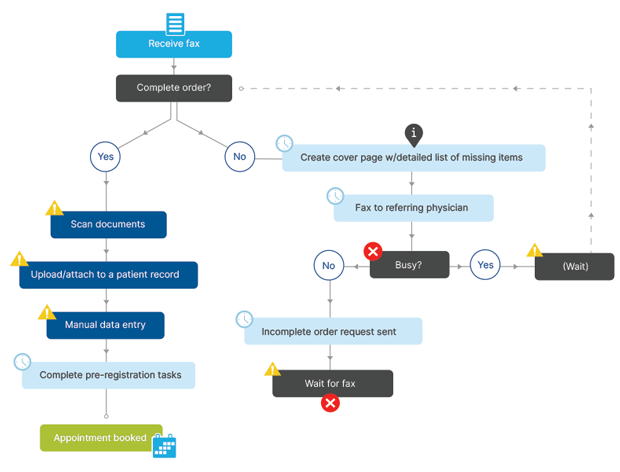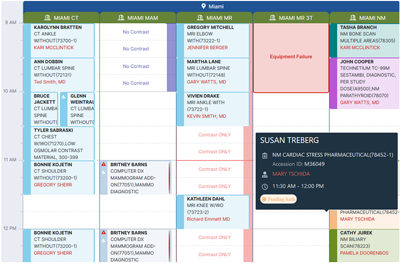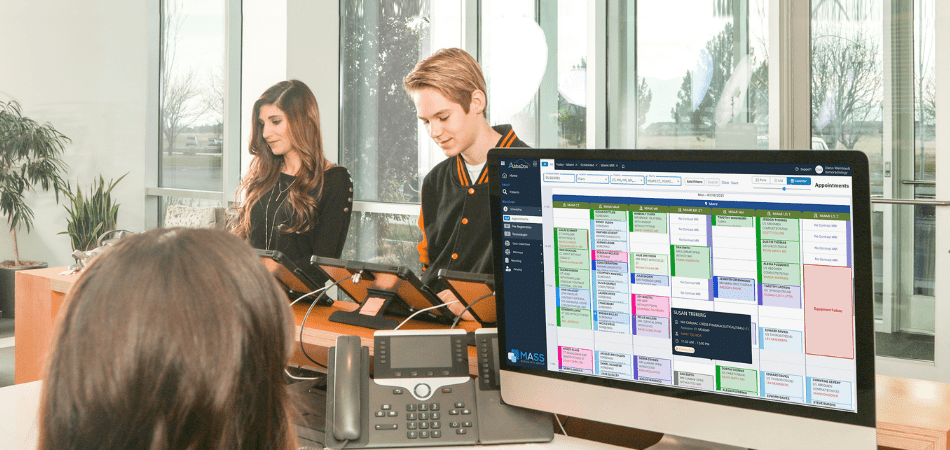Some of the biggest frustrations for radiology practice managers stem from their time-consuming, resource-draining scheduling workflows. Though scheduling may seem like a basic task for every imaging center, having an efficient scheduling workflow is key to maximizing the practice’s bottom-line. So why are so many scheduling workflows incredibly cumbersome?
There are a number of reasons why radiology scheduling workflows are hindering operations at diagnostic imaging centers across the country.
Your Preregistration Process Is Manual
Manual data entry is one of the biggest bottlenecks for medical practices across the country, especially in highly specialized fields like radiology. Centers that receive manual faxes for preregistration documents like incoming orders and intake forms must spend an inordinate amount of time sorting, organizing, scanning, and inputting the information into their RIS systems.
Subsequently, when the process is manual, it can be difficult to discern which patients are missing critical information prior to their appointments. If incoming orders from referring physicians are determined to be incomplete, staff must first create a cover page listing out the missing items, and then manually fax it back. Corrected order requests then need to be monitored and followed up on to ensure all pertinent information is received in a timely manner. This significantly extends the turnaround time to schedule critical care examinations for patients and leaves a lot of room for human error.
A RIS system that leverages digital faxes and promotes automated intake processes can greatly reduce (and even completely eliminate) that extensive document queue that detracts from achieving much-needed administrative efficiency. Automated rejections and digitally created cover pages for incomplete orders also cut down the amount of precious time patients need to wait before critical examinations and diagnostic testing can be scheduled.
Click the arrows below to see the difference between a traditional, fax-based preregistration workflow and an optimized digital faxing workflow integrated with cloud RIS technology.
Manual Workflow

Optimized Preregistration Workflow

Appointments Can Only Be Scheduled by Calling Your Practice

It’s a delicate balance. Radiology practice managers ultimately want to find that sweet spot between maximizing the number of patients a practice can see and keeping all patients who enter the practice satisfied. Overbooking can cause long wait times and ultimately reduce the quality of care by rushing technicians and radiologists to stay on schedule.
Automated appointment workflows and patient self-scheduling capabilities give practices more flexibility in time blocking. It allows practice managers to effectively space out appointments around average appointment durations, equipment maintenance, and proper sanitization and cleaning protocols, while patients basically fill in the appointment slots themselves. The seamless interoperability between back-end scheduling software and front-facing patient text messages, websites, apps, or patient portals, allows this process to flow smoothly and consistently, without the need for much manual intervention. Plus, the additional time that is given back to administrative staff can be dedicated to elevating the patient care experience.
Patient Paperwork Is Filled Out and Processed In-Person
This is one of the biggest bottlenecks for incoming appointment workflows. When patients first begin filling out paperwork upon arrival, the staff takes on an additional time-consuming manual entry process. This slows down the flow of patients checking in as if they arrive on time, they’re already late. As questions pop-up, and the time lengthens before a patient can be seen, it sets the entire schedule behind. Going green with paperless check-ins has a vast number of benefits for radiology imaging centers.

First, it is significantly more cost-effective as it minimizes the amount of capital practices need to invest in printers, maintenance, ink, and paper. It also drastically reduces the amount of human error (and potentially costly medical errors) and streamlines a manual process into an optimized, automated one. Finally, it improves the patient experience, as they are able to fill out paperwork from the comfort of home on their computers or smartphones. Nobody wants to touch a clipboard right now
No-Shows Are Frequent Occurrences
Your RIS System and Other Critical Scheduling Applications are Disjointed

A Simple Solution to Your Scheduling Workflow Frustrations
In order to improve operational efficiencies, streamline patient scheduling workflows, and enhance the patient experience, diagnostic imaging centers must have a clear strategy in place to minimize disruptions to their workflows.








